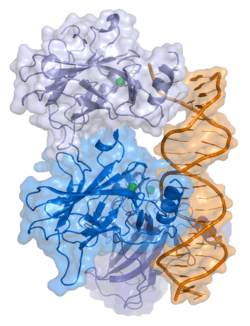HT-29
HT-29 is a human colon cancer cell line used extensively in biological and cancer research.[1]
Characteristics

Initially derived in 1964 by Jorgen Fogh from a 44-year-old Caucasian female, HT-29 cells form a tight monolayer while exhibiting similarity to enterocytes from the small intestine. HT-29 cells overproduce the p53 tumor antigen, but have a mutation in the p53 gene at position 273, resulting in a histidine replacing an arginine. The cells proliferate rapidly in media containing suramin, with corresponding high expression of the c-myc oncogene. However, c-myc is deregulated, but may have a relation with the growth factor requirements of HT-29 cells.[2]
Applications
In preclinical research, HT-29 cells have been studied for their ability to differentiate and thus simulate real colon tissue in vitro, a characteristic that has made HT-29 useful for epithelial cell research.[3] The cells can also be tested in vivo via xenografts with rodents. HT-29 cells terminally differentiate into enterocytes with the replacement of glucose by galactose in cell culture, and with the addition of butyrate or acids, the differentiation pathways can be closely studied along with their dependence on surrounding conditions.[1] Accordingly, studies of HT-29 cells have shown induced differentation as a result of forskolin, Colchicine, nocodazole, and taxol,[4] with galactose-mediated differentiation also causing the strengthening of adherens junctions.[5]
Culturing
Though HT-29 cells can proliferate in cell culture lacking growth factors with a doubling time of around 4 days, the doubling time can be reduced to one day with added fetal bovine serum.[2] The cells have high glucose consumption, and in standard medium containing 25 mM glucose and 10% serum, remain undifferentiated.[1]
References
- Martínez-Maqueda, D; et al. (2015). "HT29 Cell Line". The Impact of Food Bioactives on Health. Springer. pp. 113–124. doi:10.1007/978-3-319-16104-4_11. ISBN 978-3-319-15791-7. PMID 29787047.
- Coudray, Anne-Marie; et al. (1 December 1989). "Proliferation of the Human Colon Carcinoma Cell Line HT29: Autocrine Growth and Deregulated Expression of the c-myc Oncogene" (PDF). Cancer Research. 49: 6566–6571.
- Hirn, M; et al. (1988). "HT-29 cells are an in vitro model for the generation of cell polarity in epithelia during embryonic differentiation". Proceedings of the National Academy of Sciences. 85 (1): 136–140. doi:10.1073/pnas.85.1.136. PMC 279498. PMID 3277169.
- Cohen, E; et al. (August 1999). "Induced differentiation in HT29, a human colon adenocarcinoma cell line". Journal of Cell Science. 112: 2657–2666. PMID 10413674.
- Gout, S; et al. (1 October 2004). "Early enterocytic differentiation of HT-29 cells: biochemical changes and strength increases of adherens junctions". Experimental Cell Research. 299 (1): 498–510. doi:10.1016/j.yexcr.2004.06.008. PMID 15350547.